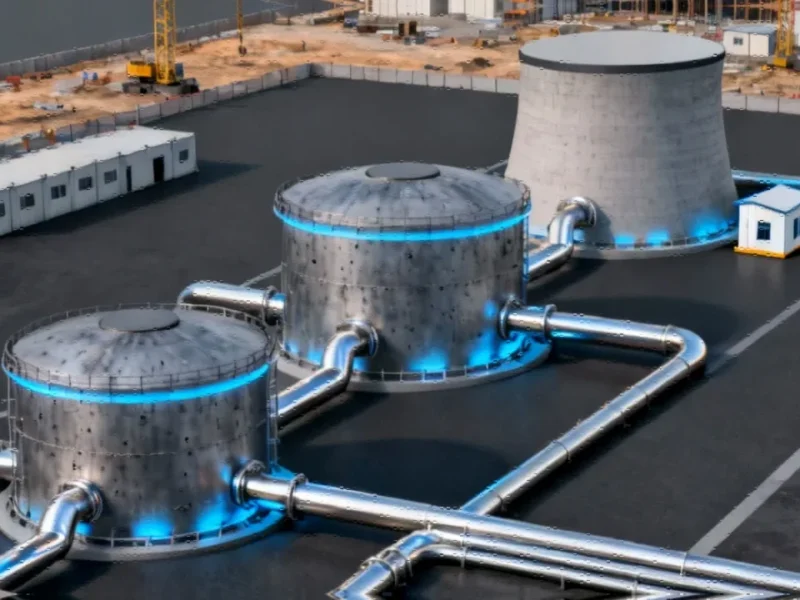Note: Featured image is for illustrative purposes only and does not represent any specific product, service, or entity mentioned in this article.
Major Nuclear Investment for Cloud Power Needs
Amazon is moving forward with ambitious plans to power its cloud infrastructure using small modular nuclear reactors, according to recent reports. The technology giant has partnered with nuclear startup X-Energy in a $500 million investment announced last fall, with plans to eventually deploy 960 megawatts of nuclear capacity in Washington State.
The initiative represents one of the most significant corporate investments in next-generation nuclear technology to date. Sources indicate that Amazon believes small modular reactors (SMRs) could provide a solution to the massive power requirements of modern cloud computing operations while supporting sustainability goals.
Phased Deployment Strategy
According to the companies’ announcement, the nuclear deployment will occur at a new facility called the Cascade Nuclear Energy Center outside Richland, Washington. The project will be developed in three phases, with each phase delivering 320 megawatts of generative capacity using X-Energy’s 80-megawatt Xe-100 reactor designs.
Analysts suggest the scale of this project becomes clear when compared to power requirements of advanced computing systems. For context, reports indicate that xAI’s 200,000-GPU supercomputer consumes approximately 300 megawatts when fully operational, meaning the completed nuclear facility could power multiple such systems simultaneously.
Regulatory and Technological Hurdles
Despite the ambitious announcement, significant challenges remain before the project can become operational. According to reports, X-Energy’s SMR technology has not yet received Nuclear Regulatory Commission approval, which is required before construction can begin. The timeline reportedly calls for construction to start at the end of the decade, with operations beginning sometime in the 2030s.
Amazon reportedly believes that X-Energy’s small modular reactor designs should be smaller, faster to deploy, and cheaper to operate than conventional nuclear reactors. However, analysts suggest this technology remains unproven at commercial scale, with higher-than-expected operating costs having already impacted one early SMR project.
Broader Industry Trend Toward Nuclear Power
Amazon isn’t alone in pursuing nuclear solutions for power-intensive computing operations. According to industry reports, Oracle plans to field at least three SMRs to power a gigawatt-scale nuclear reactor, though specific details remain limited. Meanwhile, Google-backed Kairos Power plans to deploy a 50MW molten salt reactor outside Oak Ridge National Laboratory.
The report states that Kairos stands a better chance of delivering a working reactor on time since it has already received NRC approval for its Hermes 2 demonstrator, though like X-Energy’s project, it isn’t expected to come online until after 2030. These developments reflect broader industry developments as technology companies seek reliable power sources.
Alternative Nuclear Strategies
While investing in next-generation nuclear technology, cloud providers are also pursuing more conventional nuclear energy sources to meet immediate power demands. Early last year, Amazon reportedly acquired Cumulus Data’s atomic datacenters in a deal valued at $650 million. The facilities, located alongside the 2.5 gigawatt Susquehanna nuclear power plant in northeast Pennsylvania, could eventually scale to 960 megawatts under the agreement.
Microsoft is also pursuing nuclear energy, reportedly helping to finance the re-ignition of the Three Mile Island Unit-1 reactor. According to sources, this is not the same reactor that experienced a partial meltdown in 1979, and the reactor is now expected to begin operations again starting in 2027. These moves represent significant market trends in corporate energy sourcing.
Long-Term Vision Despite Uncertainties
Despite the regulatory and technological challenges, Amazon remains confident in the technology and reportedly plans to deploy 5 gigawatts worth of X-Energy SMRs by 2039. The companies have enlisted South Korea’s Doosan Enerbility and Korea Hydro and Nuclear Power to support SMR deployment across the United States.
The partnership represents a significant bet on the future of sustainable energy for power-intensive industries. As Amazon and other technology giants continue expanding their computing capabilities, reliable and clean power sources become increasingly critical to their operations. The success or failure of these nuclear initiatives could have far-reaching implications for related innovations across the technology sector.
Industry observers note that while the timeline extends more than a decade into the future, the scale of Amazon’s commitment suggests serious confidence in the technology’s potential. However, as with any emerging technology, unexpected challenges could impact deployment schedules and costs, according to analysis of recent technology developments in the energy sector. The Register reportedly reached out to X-Energy regarding its timeline for NRC approval but had not received a response at the time of publication, highlighting the ongoing uncertainties surrounding these industry developments.
This article aggregates information from publicly available sources. All trademarks and copyrights belong to their respective owners.



